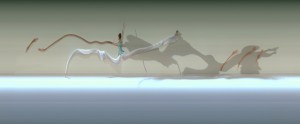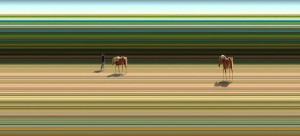An interesting article, “A Very Unusual Camera That Emphasizes Time Over Space” at the link below:
http://www.huffingtonpost.com/2012/10/15/jay-mark-johnson-time-lapse-photography_n_1967432.html
The article says:
““A slit camera emphasizes time over space. Whatever remains still is smeared into stripes, while the motion of crashing waves, cars and a Tai Chi master’s hands are registered moment by moment, as they pass his camera by. Like an EKG showing successive heartbeats, the width of an object corresponds not to distance or size, but the rate of movement. Viewing the left side of the picture is not looking leftward in space but backward in time.…a unique look is possible because the fixed-position slit camera registers only a vertical sliver of a scene. Whatever passes that slit by gets registered in a narrow line. Over a period of time, which Johnson can control, it registers line after line, The final result is a bunch of these lines all pushed together. (In this sense, you could say each photograph is actually a composite of hundreds of very skinny images.)
If you are still having trouble with this idea, try cutting out a tiny slit of paper and holding it up to your eye. Then watch something move by that slit, imagining that you are able to record what you see every half a second and line all those recordings up in a rectangle. A car taking a long time to pass the slit is stretched; while a car speeding by is scrunched up. One flitting dancer can fill a panorama.
The way the camera isolates subject from background allows Johnson to evoke the mood of an empty piazza painted by De Chirico or the sense of estrangement and abandon depicted by Sartre.
He says he opts for this unusual camera because he wants to hold a mirror to human nature, that expands our view of reality. As he explained, “It shows us that what we see is a product of our cultural traditions and means of perception.â€
It is mind-blowing to think that something so seemingly surreal is actually just a different, but incredibly accurate, way of processing reality.”
There are parallels with TSK, and the way it looks at experience in a different way to expand our view of reality.



Looking forward to tomorrow’s first class. Would like to take a look at the ‘class materials’ here, but it seems the website here doesn’t recognize me as a student as I only get “Sorry, these are class materials.” (interestingly, I’m able to post a comment for just this one topic, despite not being allowed to see the “interesting article”).
Thanks David
This is exciting and certainly expands and /or contracts our view.
but brings into question the notion of “reality”.
Hayward
I was imagining if I were to see Time in the way described above, where “A car taking a long time to pass the slit is stretched; while a car speeding by is scrunched up. One flitting dancer can fill a panorama.” Depending on what is moving in a given field of vision, there might be a series of stacked unbroken lines, which represents what seems unchanging in time — kinds of ‘time-lines’ we are not used to seeing. It occurred to me that for humans, we might view time as unbroken lines but for our habit of narrating to ourselves what is going on. It seem to be the narration that parcels discrete or overlapping moments, contextual stories, that measures out time-lines.